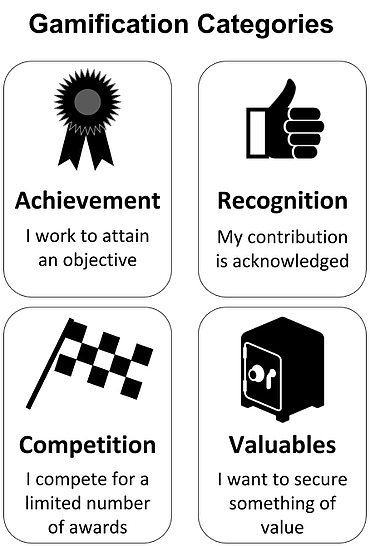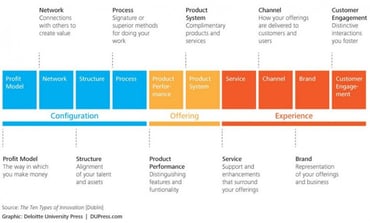Editor's Note: This blog post was co-authored by Natalie Turner.
When we talk about innovation, we often talk about harnessing people's creative energies, and then turning that energy into something of value. How can we help people collaborate and create new things?
Innovation, at its heart, is a challenge. For the last 15 years, I've been working to help people connect, collaborate, and use collective intelligence to address key innovation needs. However, people don't always behave as we expect. As we all come from different cultures and have different motivations, a people-centric view of innovation is critical to unlocking creative potential.
About The Six 'I's® of Innovation
With this in mind, I'd like to share some details of the Six 'I's® of Innovation, which has people and purpose at its heart. Invented by Natalie Turner and popularized in her book, "Yes, You Can Innovate," The Six 'I's® perspective mirrors the unpredictable and iterative human journey that ideas take from inception to creating something valuable.
Each of The Six 'I's® requires different skills, capabilities, and supporting processes that an organization must maximize to innovate consistently and effectively.
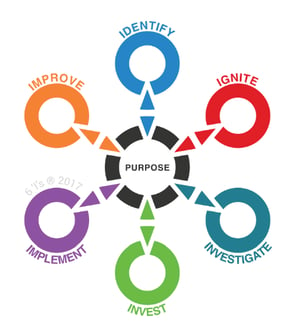
Real innovation happens only when you are able to IDENTIFY an opportunity, IGNITE ideas and solutions, INVESTIGATE ideas to see if they will work, INVEST in the best ones, IMPLEMENT the idea in the world, and IMPROVE on the idea to see if it can create more value.
Adopting the Six 'I's® across large complex organizations can be supercharged by systems that follow the same principles.
HYPE Innovation partnered with Turner to incorporate the Six 'I's ® methodology into our innovation software, enabling entire organizations to execute innovation in a people-centric way, covering all of the six profiles that innovators tend towards.
Below, I break down each of the Six ‘I's® and how each role uses different areas of the HYPE Enterprise Suite to build a strong and sustainable innovation program.
1. Identifiers
Identifiers perceive themselves as being good at visualizing and imagining the future. They can understand trends and patterns and think about what these trends might mean for opening fresh opportunities to do things differently. They are usually forward-thinking, strategic, and tend to notice things that other people don't.
Typically very curious, Identifiers may have lots of different interests and a huge appetite for learning. From a leadership perspective, they enjoy providing strategic focus to their teams and organizations.
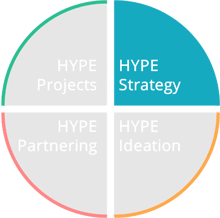
In HYPE, Identifiers will often operate within our Strategy product, scanning the external environment, bringing together trends, research, competitive insights, and capabilities to create a vision or set of options for the future, eventually contributing to a roadmap of innovation work.
2. Igniters
Igniters see themselves as being idea generators and are usually the first to come up with new ideas. They continually seek new knowledge outside their current areas of interest and like to challenge other people's thinking as well as their own. They tend to be original thinkers but are also good at thinking laterally – seeing connections between different and unrelated ideas.
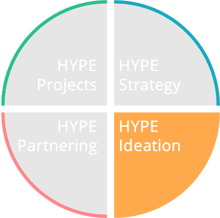 In HYPE, Igniters will typically help respond to the big innovation questions posed. They share ideas, collaborate, and spot the underlying trends that others can't see. Not only are they good ideators, they're also good moderators for idea campaigns and open channels as they can see connections and build bridges between different parts of the company.
In HYPE, Igniters will typically help respond to the big innovation questions posed. They share ideas, collaborate, and spot the underlying trends that others can't see. Not only are they good ideators, they're also good moderators for idea campaigns and open channels as they can see connections and build bridges between different parts of the company.
In some cases, you may see Igniters offering inspiration to others, sharing observations and experiences upon which others can develop.
3. Investigators
Investigators perceive their strengths as being able to systematically research, analyze, and assess ideas. They're also good at ensuring that ideas are useful, not just novel. They understand the importance of testing and validating ideas before moving into implementation and will strive to test their thinking with customers and stakeholders. These skills are crucial, especially in open innovation. Involving key stakeholders or customers in the innovation process will ensure that what is being created will generate value.
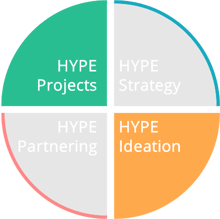 Investigators will typically support three distinct areas within HYPE. They're often involved in open innovation campaigns, assessing and moderating the content received from external stakeholders. They're also very effective idea and concept evaluators, able to make judgments and compare different options. Investigators take part in evaluation teams and on gate review committees within HYPE's Projects phase.
Investigators will typically support three distinct areas within HYPE. They're often involved in open innovation campaigns, assessing and moderating the content received from external stakeholders. They're also very effective idea and concept evaluators, able to make judgments and compare different options. Investigators take part in evaluation teams and on gate review committees within HYPE's Projects phase.
In some cases, they may initiate “Validation” or “Testing” campaigns, where internal or external stakeholders are asked to share feedback and insights on partially completed work to ensure it can be refined and improved.
4. Investors
Investors recognize their strengths as being good at assessing and sanctioning detailed business plans, making pragmatic decisions under stressful conditions, and judging where and when to allocate resources. These are essential innovation skills, as innovation requires saying "no" as well as "yes," as time and resources are often limited, and Investors must make difficult choices.
Investors are often skilled at influencing other organizations and people to create partnerships. They also see themselves as strong at enabling others to communicate a compelling case for investment in their ideas. Investors also dare to take risks. Risk is an inherent part of leading innovation as one must make decisions without knowing whether something will succeed.
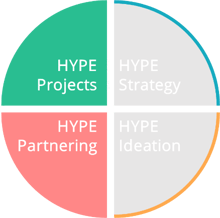 Investors are often involved in two phases of the HYPE application. They are approvers of concepts and projects, judging priorities, resources, and investment required. Additionally, they may also be involved in HYPE Partnering, helping identify new third parties that could add material value to the business.
Investors are often involved in two phases of the HYPE application. They are approvers of concepts and projects, judging priorities, resources, and investment required. Additionally, they may also be involved in HYPE Partnering, helping identify new third parties that could add material value to the business.
5. Implementers
Implementers perceive their strengths as being good at planning, organizing, and making things happen. They also have strengths in managing risks. This is the hard work of innovation, as it involves executing a plan and getting things done. Managing risk is a critical skill, as being able to scan the horizon and see where there might be potential problems can save a lot of time and money in the long run.
From a leadership perspective, Implementers perceive themselves as effective at keeping people motivated to deliver on time and budget. They are also adept at building the right team with the necessary talents. These are vital leadership skills, as implementation requires forming and developing strong teams with diverse experiences and competencies. Being able to motivate others can also help drive productivity and efficiency and create a culture of innovation where people feel motivated to succeed.
 In HYPE, Implementers will typically spend most of their time in the Projects phase, executing a plan. However, they may also harness collective intelligence to help solve problems quickly or find new ways to make their project even better with inquiry campaigns, not to look for new ideas, but to assess and mitigate risks.
In HYPE, Implementers will typically spend most of their time in the Projects phase, executing a plan. However, they may also harness collective intelligence to help solve problems quickly or find new ways to make their project even better with inquiry campaigns, not to look for new ideas, but to assess and mitigate risks.
6. Improvers
Improvers perceive their strengths as being good at generating many ways to make an idea better and at seeking opportunities to improve on ideas with various people, customers, or stakeholders. These are essential skills, as a lot of innovation comes from optimizing and extracting more value from an existing idea. It is the end-user, or ultimate customer, who can often give the best suggestions for improvement.
Reviewing and assessing what worked or didn't work (and why) and communicating success and lessons learned are also perceived as strengths.
From a leadership perspective, Improvers perceive their strengths as two-fold: capturing learning, resulting in continuous improvement, and creating a culture where people can learn from success and failure.
 Improvers capture outcomes and best practices in HYPE either via inquiry campaigns or in official project summaries once something has been implemented. They make excellent innovation curators, a growing role in progressive organizations, and they can often drive greater value from things that already exist.
Improvers capture outcomes and best practices in HYPE either via inquiry campaigns or in official project summaries once something has been implemented. They make excellent innovation curators, a growing role in progressive organizations, and they can often drive greater value from things that already exist.
Summary
To really change culture, we need to think about these different innovation profiles as much as we consider the processes and supporting applications. Improving innovation performance can only come when we have a people-centric approach – respecting the culture we have today, providing a vision for where it needs to move, and ensuring that all innovation profiles are part of our process.
Want to find out more about how you could use The Six ‘I’s® of Innovation in your organization and discover your innovation strengths? Please visit The Six ‘I’s® website, take the online Six ‘I’s® self-assessment here, or contact HYPE to see a how you can use the Six ‘I’s® within our innovation platform.








